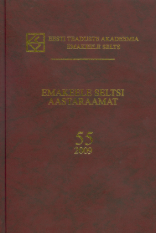VÕÕRSÕNADE KUJU FIKSEERUMISE PÕHIJOONI EESTI KEELES 1918─2018
MAIN FEATURES OF THE FIXATION OF THE SPELLING OF FOREIGN WORDS IN ESTONIAN FROM 1918─2018
Author(s): Tiina PaetSubject(s): Recent History (1900 till today), Lexis, Historical Linguistics, Sociolinguistics, Finno-Ugrian studies
Published by: Teaduste Akadeemia Kirjastus
Keywords: language history; historical linguistics; language contacts; language planning; foreign words;
Summary/Abstract: According to the survey and analysis of the spelling norms of a century ago, which is presented in the article, over 2000 words (every tenth word) of the 20,000 entries included in the first Estonian spelling dictionary (EKÕS) published in 1918 are of foreign origin, 365 of which have since been subject to spelling changes, stem replacement or loss from use. The main trends observed are as follows: a lengthening or shortening of the phonetic shape of words, a loss of certain elements typical of the source or mediating language (e.g. the loss of the endings -ismus- and -us); a shortening of the vowel in the non-initial syllable accompanied by stress shifting to the first syllable, alternation between i and ü (in words of Greek origin), changes in verb and adjective suffixes, as well as some semantic changes. 50 of the 2054 words analysed have failed to make their way to the newest Dictionary of Standard Estonian (ÕS 2018). About 15 of those 50 can still be found in the Lexicon of Foreign Words, while eight (8) have fallen into oblivion and the rest are derivatives not included among the entry words in the modern Dictionary of Standard Estonian (ÕS 2018). The ending -ismus survived longer than -us, which was practically gone by 1925 except in the parallel forms for two entry words batsill (batsillus) ‘bacillus’ and hümn (hümnus) ‘anthem’ presented in the second edition of the dictionary. In the Small Spelling Dictionary of 1933 the ending -us was dropped from those two words as well. The dictionary of 1925 reveals a vowel shortening in the non-initial syllable, except in the words martsipaan ‘marzipan’, oktaav ‘octave’, plataan ‘sycamore’, sümptoom ‘symptom’, tsükloon ‘cyclone’, and veteraan ‘veteran’. The 1937 edition of the Small Spelling Dictionary presents those words in the same shape except for martsipa[a]n, where a short vowel is accepted as admissible. In some of the Estonian words the long vowel in the non-initial syllable can be explained by its origin lying in a long Latin or Arabic vowel, while in the rest it is either occasional or follows the principle of analogy. Nowadays (in ÕS 2018) we find the forms sümptoom, oktaav, and plataan presented as parallel entries placed second to their short-vowel equivalents. Although with time foreign words tend to adapt to the receiving language by getting simpler and acquiring some traits of the target language, there are also contrary examples, where EKÕS 1918 contains a rather Estonian-like spelling that has since become closer to the source by acquiring some foreign traits. By the time EKÕS was compiled the Estonian language had mainly been in contact, for political reasons, with German and Russian, which thus came to serve as mediating languages for other source languages. Most of the words borrowed before 1880 either originate in German or have been mediated by German. Russian mediation was at its height from early 1880s, when Russianization began, up to 1920, when Russian lost its position in Estonia due to a change in the political situation. Although the mediating language cannot always be definitely asserted, it is sure that most of the vocabulary analysed has been mediated to Estonian by German.
Journal: Emakeele Seltsi aastaraamat
- Issue Year: 2017
- Issue No: 63
- Page Range: 139-165
- Page Count: 27
- Language: Estonian

